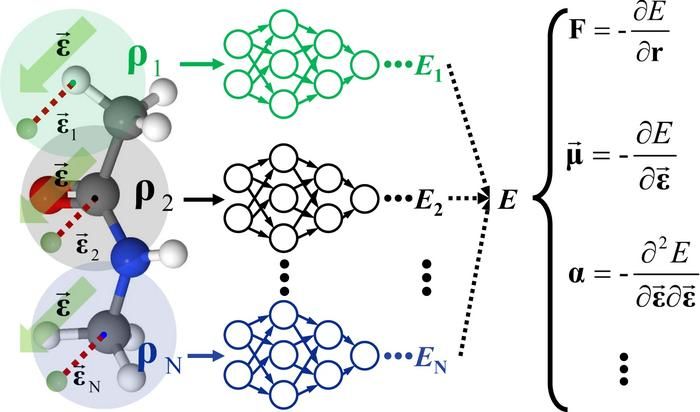Novel machine learning model for molecular simulation under external field
Prof. JIANG Bin’s research team at the University of Science and Technology of China (USTC) developed a universal field-induced recursively embedded atom neural network (FIREANN) model, which can accurately simulate system-field interactions with high efficiency.

Schematics of FIREANN framework.
Prof. JIANG’s team
Atomic simulation plays a crucial role in understanding the spectra and dynamics of complex chemical, biological, and material systems at microscopic level. The key to atomic simulations is finding the accurate representation of high-dimensional potential energy surfaces (PESs). In recent years, using atomistic machine learning (ML) models to accurately representing PESs has become a common practice. However, most ML models only describe isolated systems and can’t capture the interactions between external fields and the systems, which can change the chemical structure and control the phase transition via field-induced electronic or spin polarization. A novel ML model taking external fields into account is urgently needed.
To tackle this problem, Prof. JIANG's research team proposed an “all-in-one” approach. The team first treated external field as virtual atoms and used embedded atom densities (EADs) as descriptors to atomic environment. The field-induced EAD (FI-EAD) was derived from the linear combination of the field-dependent orbital and coordinate-based orbitals of atoms, which captures the nature of the interaction between external field and the system, leading to the development of FIREANN model.
This model accurately correlates various response properties of the system, such as dipole moment and polarizability, with the potential energy changes that depend on external fields, providing an accurate and efficient tool for the spectroscopy and dynamics simulations of complex systems under external fields.
The team verified the capability of FIREANN model by conducting dynamical simulations of N-methylacetamide and liquid water under strong external electric field, both demonstrating high accuracy and efficiency. It is worth mentioning that for periodic systems, FIREANN model can overcome the inherent multiple-value issue of the polarization by training with atomic forces data only.
This research filled the gap of lacking accurate external field representation in ML model, which will contribute to the advancement of molecular simulations in chemistry, biology, and materials science.
Original publication
Other news from the department science

Get the analytics and lab tech industry in your inbox
By submitting this form you agree that LUMITOS AG will send you the newsletter(s) selected above by email. Your data will not be passed on to third parties. Your data will be stored and processed in accordance with our data protection regulations. LUMITOS may contact you by email for the purpose of advertising or market and opinion surveys. You can revoke your consent at any time without giving reasons to LUMITOS AG, Ernst-Augustin-Str. 2, 12489 Berlin, Germany or by e-mail at revoke@lumitos.com with effect for the future. In addition, each email contains a link to unsubscribe from the corresponding newsletter.
























































